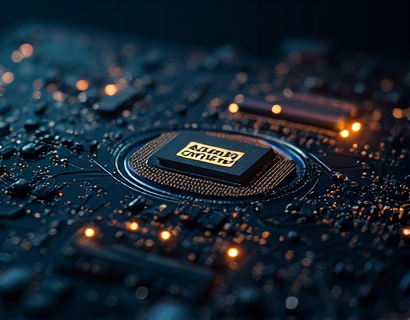Revolutionizing Decentralized Finance: Smart Contract Driven Creation of UCASH-Pegged Stablecoins for Seamless DeFi Exchange
The advent of blockchain technology and decentralized finance (DeFi) has opened new avenues for financial innovation, offering users unprecedented levels of security, transparency, and control over their assets. Among the most significant developments in this space is the smart contract driven creation of stablecoins pegged to UCASH, a move that promises to revolutionize the way digital currencies operate within the DeFi ecosystem. This approach not only enhances the stability and flexibility of digital currencies but also provides a secure, efficient, and user-friendly solution that sets a new standard in the crypto economy.
Stablecoins have become a cornerstone of the cryptocurrency market, serving as a stable store of value and a medium of exchange due to their peg to traditional fiat currencies or other stable assets. However, traditional stablecoin issuance and management often involve centralized entities, which can pose risks in terms of trust, security, and regulatory compliance. The introduction of smart contract driven UCASH-pegged stablecoins addresses these concerns by leveraging the inherent advantages of blockchain technology.
Smart contracts, self-executing contracts with the terms directly written into code, play a pivotal role in this innovative approach. These contracts automatically enforce and execute the rules governing the creation, management, and trading of stablecoins, eliminating the need for intermediaries and reducing the risk of human error or fraud. By utilizing smart contracts, the process of creating UCASH-pegged stablecoins becomes more transparent, secure, and accessible to a broader audience.
The process begins with the deployment of a smart contract on a blockchain platform, such as Ethereum, which is designed to manage the issuance and circulation of the stablecoin. This contract defines the parameters for pegging the stablecoin to UCASH, including the algorithm used for maintaining the peg, the reserve requirements, and the mechanisms for adjusting the supply in response to market conditions. The smart contract ensures that for every stablecoin issued, a corresponding amount of UCASH is locked in a smart contract reserve, providing a direct and transparent link between the stablecoin and its underlying asset.
One of the key benefits of this smart contract driven approach is the bidirectional exchange capability. Users can seamlessly convert UCASH into the pegged stablecoin and vice versa, without the need for centralized exchanges or intermediaries. This bidirectional functionality enhances the liquidity and usability of the stablecoin, making it a more attractive option for traders and investors in the DeFi space. The smart contract automatically manages the conversion process, ensuring that the peg is maintained at all times and that the supply of stablecoins adjusts dynamically to market demand.
The smart contract also incorporates robust security measures to protect the stablecoin and its reserves. Multi-signature wallets and threshold signatures are employed to ensure that no single entity can manipulate the system. Additionally, regular audits and transparency reports are integrated into the smart contract, allowing users to verify the integrity of the system and the accuracy of the reserves at any given time. This level of transparency builds trust among users and fosters a more inclusive and decentralized financial ecosystem.
Another significant advantage of smart contract driven stablecoins is their flexibility. Unlike traditional stablecoins that may require significant capital and regulatory approvals to launch and maintain, these smart contract based stablecoins can be deployed quickly and with minimal overhead. This agility allows for rapid response to market changes and the ability to tailor stablecoins to specific use cases or communities. For instance, a stablecoin pegged to UCASH can be customized to cater to the needs of a particular DeFi application or community, enhancing its relevance and utility.
The impact of this technology on the DeFi landscape is profound. By providing a secure and efficient means of creating and trading stablecoins, smart contracts lower the barriers to entry for DeFi participants. This democratization of financial tools empowers a wider range of users, from individual investors to institutional players, to engage in decentralized trading, lending, borrowing, and other financial activities. The enhanced stability and flexibility of UCASH-pegged stablecoins make them ideal for a variety of DeFi applications, including yield farming, liquidity provision, and decentralized exchanges.
Moreover, the integration of smart contracts with UCASH-pegged stablecoins paves the way for innovative financial products and services. For example, decentralized lending platforms can offer collateral options using these stablecoins, providing borrowers with more stable and reliable collateral choices. Similarly, decentralized exchanges can benefit from the low slippage and high liquidity provided by these stablecoins, enhancing the overall trading experience for users. The versatility of smart contract driven stablecoins opens up numerous possibilities for financial innovation in the DeFi space.
From a technical perspective, the implementation of smart contract driven UCASH-pegged stablecoins involves several key components. First, the smart contract itself must be carefully designed to ensure compliance with the desired peg mechanism. This typically involves implementing an algorithm that adjusts the supply of stablecoins based on the difference between the stablecoin's value and the value of UCASH. For instance, if the stablecoin's value begins to deviate from the peg, the smart contract can automatically sell or buy UCASH to restore the equilibrium.
Second, the smart contract must include mechanisms for user interaction, such as functions for depositing and withdrawing UCASH, converting to and from the stablecoin, and checking the current peg rate. These functions are designed to be user-friendly and secure, ensuring that users can interact with the stablecoin without compromising the integrity of the system. Additionally, the smart contract can incorporate governance features, allowing token holders to propose and vote on changes to the smart contract parameters, further enhancing the decentralized nature of the stablecoin.
To ensure the stability and reliability of the smart contract, extensive testing and auditing are conducted before deployment. This includes formal verification to mathematically prove the correctness of the smart contract logic, as well as security audits to identify and mitigate potential vulnerabilities. By prioritizing security and reliability, the smart contract driven approach builds a strong foundation for the stablecoin and the broader DeFi ecosystem.
The adoption of smart contract driven UCASH-pegged stablecoins also has significant implications for the regulatory landscape. By providing a transparent and tamper-proof system for managing stablecoins, these smart contracts can help address some of the regulatory concerns surrounding traditional stablecoins. Regulators can more easily monitor and oversee the operations, ensuring compliance with financial regulations while maintaining the decentralized and trustless nature of blockchain technology. This balanced approach can facilitate the integration of stablecoins into the mainstream financial system, paving the way for broader adoption and acceptance.
In conclusion, the smart contract driven creation of UCASH-pegged stablecoins represents a significant advancement in the field of decentralized finance. By leveraging the power of blockchain and smart contracts, this approach offers a secure, efficient, and user-friendly solution for managing digital currencies. The bidirectional exchange capability and enhanced flexibility of these stablecoins make them a valuable asset for DeFi participants, driving innovation and expanding the possibilities of decentralized finance. As the technology continues to evolve, it is poised to play an increasingly important role in shaping the future of the crypto economy.










































